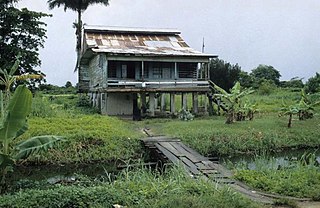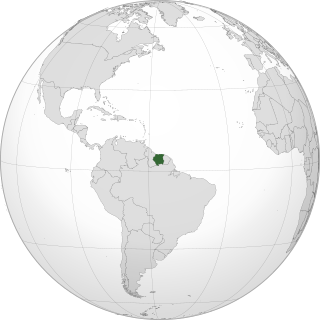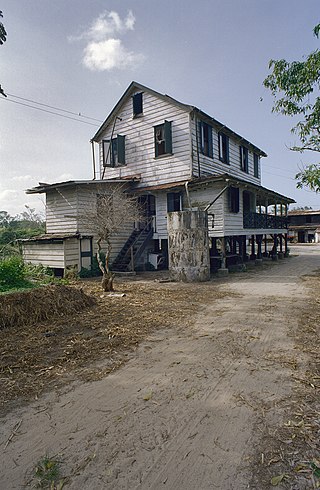
Suriname, officially the Republic of Suriname, is a country in northern South America, sometimes considered part of the Caribbean and the West Indies. Situated slightly north of the equator, over 90% of its territory is covered by rainforests, the highest proportion of forest cover in the world. Suriname is bordered by the Atlantic Ocean to the north, French Guiana to the east, Guyana to the west, and Brazil to the south. It is the smallest country in South America by both population and territory, with around 612,985 inhabitants in an area of approximately 163,820 square kilometers. The capital and largest city is Paramaribo, which is home to roughly half the population.

Cynthia Henri McLeod is a Surinamese novelist known for her historic novels and whose debut novel instantly made her one of the most prominent authors of Suriname.

Meerzorg is a town and resort (municipality) in Suriname, located on the eastern bank of the Suriname River, directly opposite the capital Paramaribo. Its population at the 2012 census was 12,405. Since 2000 it has been connected to Paramaribo by the Jules Wijdenbosch Bridge, named after the former President Jules Wijdenbosch.

Beekhuizen is a former sugarcane plantation and currently a resort in Suriname, located in the Paramaribo District. Its population at the 2012 census was 17,185.

Centrum is a resort in Suriname, located in the Paramaribo District. Its population at the 2012 census was 20,631. The historical centre of Paramaribo is located within the resort. The city centre is mainly in original condition, contains 291 listed monuments, and has of 2002 been designated a UNESCO World Heritage Site.

Afro-Surinamese are the inhabitants of Suriname of mostly West African and Central African ancestry. They are descended from enslaved Africans brought to work on sugar plantations. Many of them escaped the plantations and formed independent settlements together, becoming known as Maroons and Bushinengue. They maintained vestiges of African culture and language. They are usually split into two ethnic subgroups.

Kathleen Gertrud Ferrier is a former Dutch politician of Surinamese descent and development aid worker. She served as a member of parliament of Netherlands representing the party Christian Democratic Appeal from 2002 to 2012.

Mariënburg is a former sugarcane plantation, factory and village, situated in the district of Commewijne, in northern Suriname.

Netherlands–Suriname relations refers to the current and historical relations between the Netherlands and Suriname. Both nations share historic ties and a common language (Dutch) and are members of the Dutch Language Union.

The history of the Jews in Suriname starts in 1639, as the English government allowed Spanish and Portuguese Jews from the Netherlands, Portugal and Italy to settle the region, coming to the old capital Torarica.

Indonesia and Suriname established diplomatic relations on 24 January 1976. Both had a special relationship, based upon shared common history as former colonies of the Dutch Empire. Large numbers of Javanese migrated to Suriname to work on plantations during the late 19th and early 20th-centuries. Indonesia has an embassy in Paramaribo also accredited to the Co-operative Republic of Guyana, while Suriname has an embassy in Jakarta. Indonesia and Suriname are members of the World Trade Organization (WTO) and Forum of East Asia-Latin America Cooperation.
Elisabeth Samson was an Afro-Surinamese coffee plantation owner. She was born in 1715 in Paramaribo to a freed slave, known as Mariana. All of her other siblings had been born as slaves and were emancipated by her half-brother Charlo Jansz. Raised in the home of her half-sister Maria Jansz, Samson was taught to read and write by her brothers-in law who also trained her in business. She began acquiring property at the age of 19, but was banished from the colony in 1736 after being convicted of slander. Her appeal, heard by the Dutch Parliament, was successful and she returned to Suriname in 1739.

Women in Suriname are women who were born in, live in, or are from Suriname. Surinamese women may be ethnically East Indian, Creole/Afro-Surinamese, Javanese, Amerindian, Mixed, or of other ancestry. Many women of Suriname work in the informal sector and in subsistence agriculture.
The Tjin A Djie family is a family from the country of Suriname. It is one of the earliest Chinese Surinamese families, having arrived in Suriname in 1866. The descendants are known for their role as entrepreneurs and sporters. The family has been active at plantations for rice and vegetables. In the 20th and 21st centuries, descendants have been active in tennis and golf. In the 2010s The annual Opa Leo Tjin A Djie Tennis Tournament is being sponsored by them.
Maria Vlier was a Dutch Surinamese teacher who wrote the first history textbook focused on the history of Suriname. Born into an intellectual family who descended from slaves, Vlier was educated in the Netherlands and returned to Suriname to teach. Recognizing that students were being taught European history and had no knowledge of the history of their own homeland, she wrote the first textbook on the colony. The book won a silver medal at the International Colonial and Export Exhibition of 1883 and was one of the three most-used textbooks in the Surinamese education system until 1945.

Berg en Dal is a village in the resort of Klaaskreek in the Brokopondo District of Suriname. The village is located on the Suriname River.

Katwijk is coffee plantation and village in the Alkmaar resort of the Commewijne District of Suriname. It is the only coffee plantation in Suriname which is still in operation. During World War II, Katwijk was an internment camp for prostitutes.

Berlijn is a village and former wood plantation in the resort of Zuid in the Para District in Suriname. It is located on the Para Creek, and about 4 kilometres (2.5 mi) from the Johan Adolf Pengel International Airport.

The Cinema of Suriname is part of the Surinamese culture. National cinema, as a kind of artistic creativity, was born in the second half of the 70s of the 20th century.


















